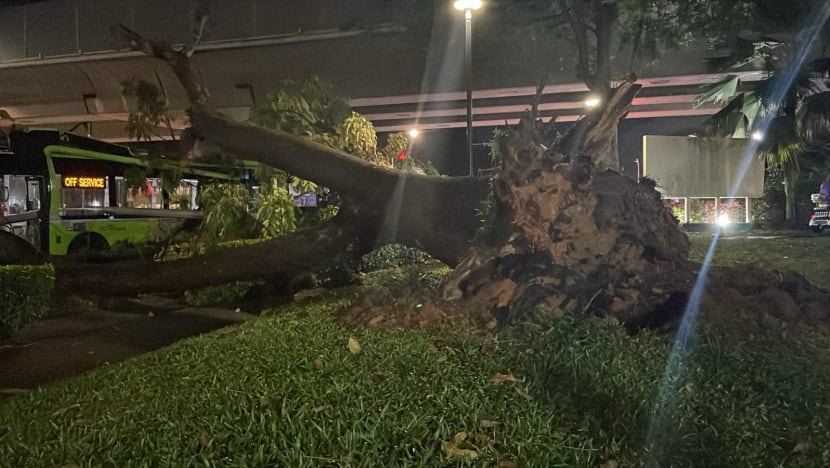Singapore authorities developing guidelines to help employers manage extreme weather risks
A Manpower Ministry spokesperson told CNA that they will finalise and release the guidelines after consultations with the industry and public.

A misting machine deployed by China Construction (South Pacific) Development Co Pte Ltd at one of its construction worksites.

This audio is generated by an AI tool.
SINGAPORE: A misting machine, in-built storage ponds and weather monitoring devices – these are some measures a construction firm in Singapore is taking to protect their workers from the elements.
The misting system helps to cool the worksite, providing some relief to those toiling under the sun. The ponds hold rainwater to prevent flooding, before the water is treated to remove silt and released into public drains.
Both measures are used in tandem with devices that track changes in weather. These gadgets give early warnings of strong winds and thunderstorms – conditions that are particularly dangerous for those working at height.
“I always reminded my fellow workers … that safety is not just a priority for a company, but it is a core value for us and we expect the same from our partners,” said Mr Qian Liangzhong, chairman of China Construction (South Pacific) Development Co Pte Ltd.
GUIDELINES TO BE RELEASED SOON
Such companies often affected by extreme weather conditions will soon be able to rely on a set of workplace safety and health guidelines, which are being developed by the Ministry of Manpower (MOM) and the Workplace Safety and Health (WSH) Council.
A ministry spokesperson told CNA that they will finalise and release the guidelines after consultations with the industry and public. It did not specify a timeline.
This comes about three weeks after MOM and the WSH Council advised companies to prepare for erratic and sudden changes in weather conditions.
The country had recently been hit by strong winds and heavy rain that toppled trees, snarled traffic and caused damage to property.
“With climate change, Singapore can expect unexpected weather conditions that would impact workplace safety and health,” said the MOM spokesperson.
“Hence, the guidelines aim to raise awareness on the likelihood of an extreme weather event and its consequences on workplaces.”
Companies will be able to seek guidance on how to prepare and respond to such events, as well as how to minimise injuries and property damage.
WETTER, WARMER SOUTHEAST ASIA
Experts told CNA that a high level of preparation is necessary, given how Singapore and its surrounding region have become prone to more frequent episodes of extreme weather.
Assistant Professor Gianmarco Mengaldo from the National University of Singapore’s College of Design and Engineering was among researchers who recently published a study on new or emerging patterns in the tropical Indo-Pacific.
Using historical data from the 1940s until present day, they identified that these patterns are due to long-term trends over the past 80 years.
“These emerging patterns are actually aggravating the frequency of extreme weather events, in particular heatwaves and extreme rainfall in this region,” said Dr Mengaldo, who is also director of the Mathematical and Computational Engineering Laboratory.
“Some possible culprits of these newer patterns that are driving more extreme weather events are global warming, possibly aerosol forcing, among others.”
Aerosol forcing refers to the contributions aerosol particles – the seeds on which clouds form – make towards the heating and cooling of the earth, including the scattering and absorption of sunlight and the distribution of clouds.
A “wetter and warmer” region will come with several consequences, he pointed out.

“We might expect flooding, especially in regions that are not well prepared for these types of extremes, and we might also witness some heat-related issues caused by heatwaves. Obviously this can create a range of problems overall,” said Dr Mengaldo.
He added that in Southeast Asia, including Singapore, people can expect extreme weather events to happen three to four times more frequently.
“We might have disruption in the supply chain if, for instance, we have neighbouring countries affected by large-scale flooding or heatwaves that can yield to crop failure, water contamination, among others.”
MORE SHELTERS, WEARABLE SENSORS?
On how Singapore could tackle growing instances of heatwaves, Dr Mengaldo recommended building more shelters and giving outdoor workers wearable sensors to monitor their health in real time.
These sensors could trigger warnings for those experiencing stress or heat-related illnesses.
For workers at China Construction (South Pacific) Development’s mixed-use condominium site in Clarke Quay, they undergo emergency evacuation drills every six months where they are taught what to do under adverse weather conditions.
They also go through regular safety briefings in both English and their native languages.

Worker Shahin Mohammed, who hails from Bangladesh, said they follow the instructions of the firm’s safety group to stop work during heavy bouts of rain.
“We stop lifting work and working at height, and we move to the resting area instead,” he added.
Mr Qian, the company’s chairman, said the new guidelines to be released by the authorities will be a good reference point for its own preventive measures.
He added that the firm has provided all its projects with the resources to handle foreseeable adverse weather challenges. It currently has 38 ongoing projects.
“Should the extreme weather persist or worsen, we’ll allocate additional resources such as deploying suitable safety technological aids to keep our workplaces and our workforce safe,” he said.


















